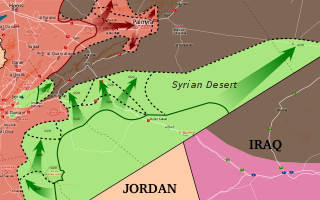 W
WPalmyra is an ancient Semitic city in present-day Homs Governorate, Syria. Archaeological finds date back to the Neolithic period, and documents first mention the city in the early second millennium BC. Palmyra changed hands on a number of occasions between different empires before becoming a subject of the Roman Empire in the first century AD.
 W
WThe Battle of Palmyra was part of the Allied invasion of Syria during the Syria-Lebanon campaign in World War II. British mechanised cavalry and an Arab Legion desert patrol broke up a Vichy French mobile column north-east of the city of Palmyra. They captured four officers and 60 men, which provoked the surrender of the Vichy garrison at Palmyra.
 W
WThe Palmyra offensive of May 2015 was a military operation launched during the Syrian Civil War by the Islamic State of Iraq and the Levant (ISIL) on May 13–26, 2015, in an attempt to capture the government-held Tadmur District of the Homs Governorate, including the administrative centre of Tadmur, known in English as Palmyra. The ruins and ancient monuments of Palmyra, which lie on the south-western fringe of the modern city, have been a UNESCO World Heritage Site since 1980. The ruins were part of a desert oasis that was one of the most significant cultural centers of the ancient world, linking the civilizations of Persia, India, China with the Roman Empire through trade. The offensive was one of the largest offensives launched by ISIL, the largest one conducted by ISIL in Syria since the 2014 Eastern Syria offensive, with the result of the offensive increasing ISIL's control of Syria to at least 50%.
 W
WThe Palmyra offensive was a military operation of the Syrian Arab Army, supported by Russian airstrikes, to recapture from the Islamic State of Iraq and the Levant the city of Tadmur, which was strategically important for both forces due to its position in central Syria. The city was fully recaptured on 27 March.
 W
WThe Palmyra offensive in December 2016 was a military operation launched by the military of ISIL which led to the re-capture of the ancient city of Palmyra, and an unsuccessful ISIL attack on the Tiyas T-4 Airbase to the west of the city. ISIL previously controlled the city from May 2015 until March 2016.
 W
WThe Palmyra offensive in 2017 was launched by the Syrian Arab Army against the armed forces of the Islamic State of Iraq and the Levant (ISIL) in the Eastern Homs Governorate in January 2017, with the goal of recapturing Palmyra and its surrounding countryside. ISIL forces had retaken the city of Palmyra in a sudden offensive from 8 to 11 December, after previously being expelled from it by Syrian government and Russian forces in March 2016. On 2 March 2017, the Syrian Army alongside Russian reinforcement, succeeded again in recapturing the beleaguered city of Palmyra.
 W
WPalmyrene Aramaic was a Western Aramaic dialect spoken in the city of Palmyra, Syria, in the early centuries AD. It is solely known from inscriptions dating from the 1st century BC to 273.
 W
WOdaenathus, the king of Palmyra from 260 to 267 CE, has been identified by modern scholars as the subject of sculptures, seal impressions, and mosaic pieces. His city was part of the Roman Empire, and he came to dominate the Roman East when in 260 he defeated Shapur I, the Sasanian emperor of Persia, who had invaded the Roman Empire. Odaenathus besieged the Sasanian capital Ctesiphon in 263, and although the city did not fall, the campaign led to a full restoration of Roman provinces taken by Shapur I. In the aftermath of his Persian war, Odaenathus assumed the title King of Kings, which was a challenge to the Persian monarch's claims of authority in the region. Odaenathus ruled the Roman East unopposed with imperial consent. In 267, he was assassinated alongside his eldest son Herodianus while conducting a campaign against Germanic raiders in Bithynia; he was succeeded by his son Vaballathus under the regency of the widow queen Zenobia.
 W
WTadmor prison was located in Palmyra in the deserts of eastern Syria approximately 200 kilometers northeast of Damascus.
 W
WThe Valley of the Tombs is a necropolis at the west of Palmyra, Syria. It is one of the three necropoleis present around the ancient city. It is one kilometre long, and easily recognizable by its tower-tombs, among which the former towers of Atenatan, Kitot, Iamblichus and Elahbel where the earliest finds of silk were made and that were destroyed by ISIS in 2015.